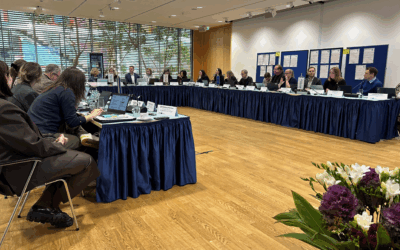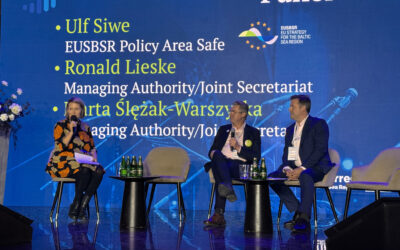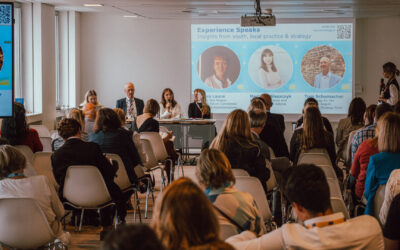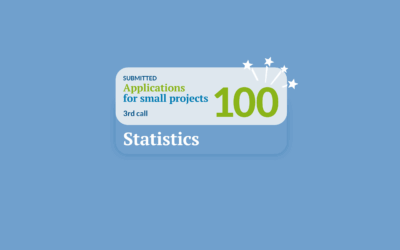14 April 2023
Taking blue biomass into circular bio-economy.
Interview with Cathy Brown Stummann from Skive Municipality
Written by Anna Zaccaro
Across the Baltic Sea region there is a pressing need to adopt more circular approaches to respond to local and global environmental challenges caused by unsustainable practices in farming and fisheries, in combination with climate change. Cathy Brown Stummann from Skive Kommune tells us what they expect to accomplish thanks to EU funding and the Interreg Baltic Sea Region support.
What’s the challenge that you want to address?
There is a fair amount of agricultural activity going on in all of our geographical areas. And with that comes a lot of nutrients, like nitrogen and phosphorus, which, for example, through rain ends up in high concentrations in our water bodies. And given that we’re all under the EU water directive, this is an issue for us all to some degree or another. It is also why we call it Blue Green Bio Lab project, because we anticipated that there would be a combination of blue and green biomasses involved in the project. We need to find new ways and approaches to take blue and green biomass into circular symbiosis processes, and that’s what we want to use the project for.
Why do you need a transnational project to tackle your challenge?
In the countries involved, we have relatively similar environmental and climatic conditions, so bio-industrial solutions produced in one area are of relevance to the other areas. One aspect of this is the knowledge, previous experience and informations sharing that we can get and combine from different partners and countries. But another important aspect is going beyond the common thinking of bio economic symbiosis in different countries. One of our partners in Latvia- the Latvian Institute of Aquatic Ecology, Agency of Daugavpils University– is at the forefront of research about mussels and their usage and involvement for the ecosystem. In Denmark, for example, there’s an expectation that it is primarily the meat from the mussels that is used for humans or animal consumption, but what about the mussels´ shells? In which way can we use them? Or what if you have these mussels growing in highly polluted areas, at that point you probably can’t have the meat for consumption but there might be some other uses. Can you for example use mussels to filter the water, what kind of effects can such an activity have over a period of time? We have to counterbalance natural science considerations with business development opportunities. Essentially, if this is actually a realistic option, how can we interact with stakeholders and talk with policy makers about implementation potential? Is there a market for this that can be sustainable and circular?
#DidYouKnow
Blue Green Bio Lab project targets the urgent challenge to reduce nutrient loads to Baltic Sea region waters, limit greenhouse gas emissions, and quickly enhance European self-supply with food, feed and energy. The project focusses on developing possibilities for circular bioeconomy symbiosis primarly in Latvia, Denmark and Sweden, but the final toolkit can possibly be applied in other countries as well. The partnership of the Blue-Green Bio Lab project is composed of Danish, Latvian and Swedish local authorities, business support organisations and applied research institutions. The local public authority partners, Skive Municipality (Denmark), Lysekil Municipality (Sweden), Zemgale Planning Region (Latvia) and Kurzeme Planning Region (Latvia) represent the primary target group in the project.
Why have you decided to lead this project?
Well, we at Energibyen Skive are a team in Skive Municipality focusing on the green transition, and one of the areas that we work on is bioeconomy. We have done some work already concerning the green bio economy with agriculture. But a growing issue for us is the blue bioeconomy, partly because we have some water bodies that are fairly polluted, and some of this has to do with run-off of nutrients from agricultural areas. Although we have some experience with the green side, we have less experience regarding the blue side, and we were looking for some inspiration from other partners that have other experiences or are dealing with similar issues. We have a strong Danish partner in the Climate Foundation that’s contributing a lot with their experience to the project because they also have several projects with focus on bioeconomy. We thought that our skills together- on our side we have a lot of experience with economy and project administration, and they have the know-how – would be a good combination to come in as a lead partner and try to develop a partnership.
What will be the result of your project? Who will benefit from these results?
Our main output will be a toolkit, which will of course benefit the target group first but can be further applied across other Baltic Sea region countries. This network that we are building with stakeholders that participate in our workshops- business organisations will also be interested. We want to find out from them, what they see as the potentials, what they see as the barriers in terms of different regulations both at the national and the EU level. This understanding will enable us to talk with policy practitioners in the next part of the project, with examples and an understanding of what is happening in the real world. So the beneficiaries are these businesses and business associations. National level policymakers will also benefit from the project in terms of developing our relationships with them, and helping them better understand the economic potentials and regulations that can be barriers to succeeding with bio-industrial symbiosis. We have seen for example in Denmark, that we can’t have a circular bioeconomy if we don’t have regulations that really understand the circular nature of what we’re trying to do.
What do you think will be most challenging for the implementation of the project?
I don’t think any of us, at least this is my impression, will have huge difficulties to talk to policy people at the national level, however to what extent we will be able to talk with people at the EU level, that’s another issue. And we have some ambitions on this regard, especially in our last group of activities before we assemble the toolkit. We are all thinking about that, but at the very least we will look into how our national level laws interact with the EU level. If it was a longer project, we might have more time to delve deeper into these issues.
#DidYouKnow
The project contributes to soluting challenges HELCOM Baltic Sea Regional strategy for Nutrient Recycling, EU Water legislation, EU Circular Economy strategy and the Soil strategy for 2030.
And what do you think will be most exciting about it?
I think that the most exciting aspect will be the discussions that are coming. I’m very excited myself to see where the businesses and entrepreneurs we involve in workshops are, where do they see investment potential and business opportunities? How similar or different are stakeholders views across countries? We also have different bodies of water at play. And, of course, the discussions we are going to have at physical partner meetings after we have talked with our policymakers will be highly fascinating. It is going to be quite exciting to hear what have been the primary issues in each country, particularly concerning the EU level. Do policymakers in Denmark, Sweden and Latvia have similar understandings or knowledge of EU regulations? Or do they see the same rules quite differently? So there’s a lot of to be excited for I guess. And also I can already see now that with some of the partners there’s a good chance that there will be an existing relationship after this project. We have some similar things we want to work on, and I think that’s one of the great things about Interreg Baltic Sea Region. We are building relationships that don’t just end because the project is over, we keep going because we will still have common challenges and opportunities that we need to focus on.
Do you want to know more about circular economy?
Don’t miss these links
More recent news
Monitoring the Programme’s progress: transnational cooperation in the making
Representatives from nine Programme area countries gathered in Berlin on 19-20 November 2025 to review the progress of the Programme’s implementation and start preparing for the post-2027 period.
Beyond Borders: Turning Interreg Results into Policy Action
At this year’s EUSBSR Annual Forum in Sopot, the session “Beyond Borders: Interreg Results in Action for a Resilient and Safe Baltic Sea Region” showcased how Interreg Baltic Sea Region projects are transforming challenges into policy-relevant results that strengthen resilience, safety, and cooperation across the region. The session brought together project partners, EUSBSR policy area coordinators, members of the Programme Monitoring Committee and young participants to explore what it takes to turn project outcomes into lasting policy impact.
How territorial cooperation builds us a home: the Baltic Sea region example
A room full of people waving their green and orange cards, prominent panelists on stage, and a clear hero of the day: territorial cooperation, making the Baltic Sea region feel like home. The joint session during this year’s EU Week of Regions and Cities was filled with positive energy, commitment and hopes for the future. What stood out most?
100 project applications: small enough to handle, big enough to matter!
The third call for small projects closed with 100 submitted applications and a whole lot of ambition. From existing challenges to transnational answers, these initiatives are proving that small can be mighty in the Baltic Sea region.






